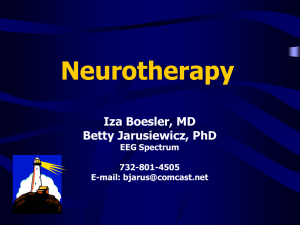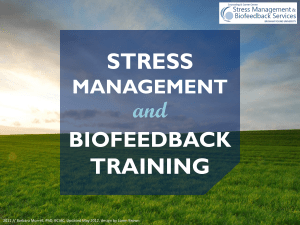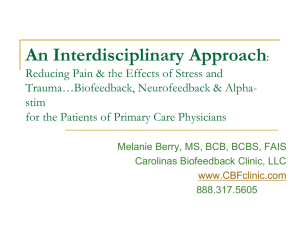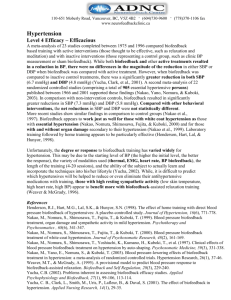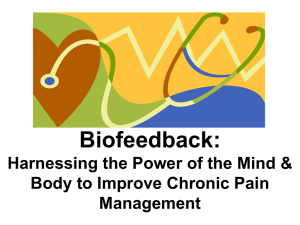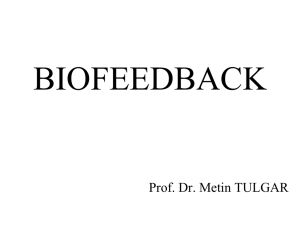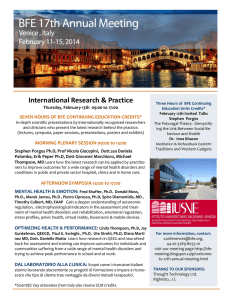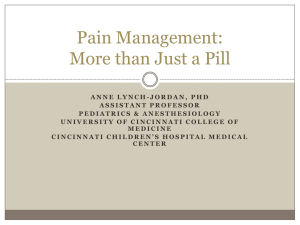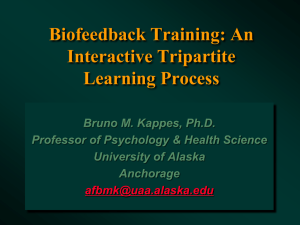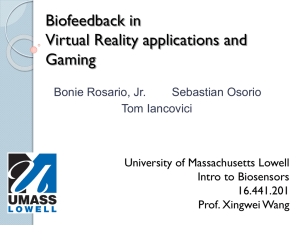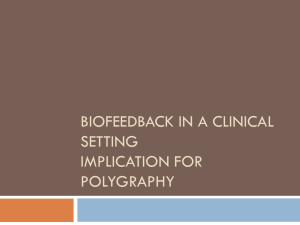treatments stress
advertisement
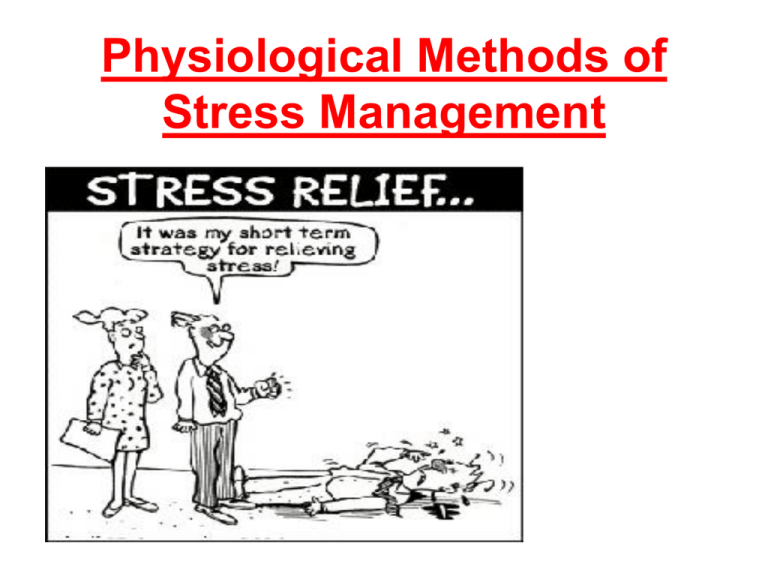
Physiological Methods of Stress Management Drug Therapies - Benzodiazepines One example of a physiological method to help stress management is the use of drug therapies. Some work by slowing down the activity of the CNS whereas some work by slowing down the activity of adrenaline and noradrenaline. An example of a drug is Benzodiazepines (BZs), which includes Librium and Valium. These slow down the activity of the CNS. Drug Therapies - Benzodiazepines How do they work? BZ’s enhance the action of GABA. GABA is a neurotransmitter and the body’s natural form of anxiety relief. When the neurons in the brain respond to this neurotransmitter, it has a quietening effect on them. The neurons do this by reacting with GABA receptors on the outside of receiving neurons. The GABA then locks into these receptors and opens a channel which increases the flow of chloride ions into the neuron. Chloride ions make it harder for the neuron to be stimulated by other neurotransmitters and so therefore slows down its activity, making the person feel more relaxed. Drug Therapies - Benzodiazepines How do they work? Serotonin is a neurotransmitter that has an arousing effect in the brain. Too much serotonin leads to anxiety, whereas low levels of serotonin leads to depression. BZs reduce any increased serotonin activity, and so in turn, reduces anxiety. Drug Therapies Sending Synaptic Gap Neuron Receiving Neuron Neurotransmitter Substance Drug Therapies – Beta-Blockers (BBs) A second example of a drug is Betablockers (BBs), which reduce the activity of adrenaline and noradrenaline. Sympathetic Branch Works with Sympathetic Adrenal Medullary System (SAM) to activate the adrenal medulla Release of adrenaline Prepares body for fight or flight response Physiological Reactions e.g. increased heart rate Drug Therapies – Beta-Blockers How do they work? Stress causes an arousal of the sympathetic nervous system (SNS) and this can lead to: - raised blood pressure - increased heart rate These then can cause: - cardiovascular disorders - reduction in the effectiveness of the immune system functioning What BBs do is reduce the activity of adrenaline and noradrenaline which are responsible for preparing the body for the “fight or flight” response. The do this by binding to receptors on the cells of the heart and other parts of the body which are usually stimulated during this arousal. Drug Therapies – Beta-Blockers What do they achieve? By blocking these receptors, it is harder to stimulate the cells. An example would be the heart; it begins to beat slower and with less force so blood vessels do not contract easily. This then leads to a fall in blood pressure which in turn means less stress on the heart. The person would begin to feel calmer and less anxious. Real World Application Lockwood (1989) studied over 2,000 musicians in major US symphony orchestras and found that 27% reported taking BBs. It was found that those musicians who had taken BBs felt better about their performance, as well as receiving a better report from critics. STRENGTHS OF DRUG TREATMENTS Effectiveness: • Drugs can be very effective in combating the effects of stress. • One way to assess effectiveness is to compare outcomes – one group of anxious patients is given a drug another group is given a placebo- a substance that has no pharmacological effects (i.e. it has no effect on the body). Patients are given medication but do not know whether it is the real thing or the placebo. This enables us to determine whether the effectiveness of the drug is due to its pharmacological properties or to something psychological (e.g. simply believing that taking the drug will make you better.) Research: • Kahn et al(1986)followed nearly 250 patients over eight weeks and found that BZ’s were significantly superior to a placebo. A meta-analysis of students focusing on the treatment of social anxiety ( Hidalgo et al,2001) found that BZ’s were more effective at reducing this anxiety than other drugs such as antidepressants. • Beta-blockers are effective in reducing anxiety in a variety of stressful situations e.g. among musicians and in sports where accuracy is more important than physical stamina ( e.g. snooker and golf) Ease of use: • One of the great benefits of using drugs for stress is that the therapy requires little effort from the user. You just have to remember to take the pills. This is much easier than the time and effort needed to use psychological methods. For example, stress inoculation therapy requires a lot of time, effort and motivation on the part of the client if it is to be effective. Weaknesses of Drug Treatments Addiction • Patients can exhibit withdrawal symptoms even with LOW doses of Benzodiazepines • This indicates a psychological dependence The more you do it The more you’ll end up doing it The more problems you’ll have Physical, psychological, social health problems The more difficulty you’ll have stopping it Physical, psychological dependence Possible Side effects • Increased aggressiveness with BZs • Impairment of memory with BZs • Some studies have linked Beta blockers to an increased risk of developmental diabetes Treating symptoms rather than the problem • Effectiveness of drug treatments for stress and anxiety • Only lasts as long as the person takes the drug because the problem itself has not been addressed A technique that trains people to improve their health by controlling certain bodily processes. There are different types of biofeedback treatments used. The 3 commonly used biofeedback treatments are as following: -Electromyography- Measures Muscle Tensions - Thermal biofeedback- Measures skin temperature - Neurofeedback- Measures the brain wave activity Neal Miller (1961) suggested that ANS (autonomic nervous system) responses could be voluntary. As a result of his experiments, he showed that such autonomic processes were controllable; this led to the creation of BIOFEEDBACK! AN EFFECTIVE RESEACRH INTO BIOFEEDBACK: Dr. Barry Sterman established that both cats and monkeys could be trained to control their brain wave pattern. He linked his study to humans and experimented on humans with epilepsy; as a result he was a able to reduce seizures by 60% using Biofeedback. Many scientists believe that relaxation is the key to a successful Biofeedback treatment. When going under chronic stress, your body has high blood pressure, Biofeedback therapy lowers this blood pressure level through a process of relaxation techniques and mental exercises. When successful, the results are shown on a monitor to the patient encouraging their efforts. It is effective for a range of health problems Lack of side effects Research has shown; It eases symptoms of “Raynaud’s disease” (a condition that causes radical blood flow to fingers, toes, nose or ears) It reduces pain It is effective in children as well; Neurofeedback has been reported to improve behaviour and intelligence scores in children with attention deficit/hyperactivity disorder. It also helps relieve abdominal pain in children Requires specialist equipment Can be more expensive and difficult to use at home than other methods. It may be the biofeedback itself that’s important; it may be the person developing a sense of control over their well being, learning simple relaxation techniques, all with a commitment to getting better. Dorkin & Miller (1986)- weren’t able to replicate Miller and Dicara’s findings with rats, which casts doubt on the response of ANS to operant conditioning. Biofeedback is… • A- a drug therapy • B- something that has many side effects • C- a therapy involving recording the bodies response to stressors Biofeedback is… •C- a therapy involving recording the bodies response to stressors Biofeedback involves the use of… • A- therapist, electrodes and monitors • B- drugs, exercise and meditation • C- reducing serotonin levels, increasing blood pressure Biofeedback involves the use of… •A- therapist, electrodes and monitors People are encouraged to… •A- try various strategies to combat the type of stress found One advantage of biofeedback is… • A- its quick and cheap • B- its effective for a range of health problems • C- establishes the causes of stress One advantage of biofeedback is… •B- its effective for a range of health problems What are the three types of biofeedback? • A- Electromyography, Thermal biofeedback, Neurofeedback • B- Neurofeedback, Thermal biofeedback and systematic desensitization • C- Electromyography, Neurofeedback and emotion focused coping What are the three types of biofeedback? •A- Electromyography, Thermal biofeedback, Neurofeedback What is GABA? A- a Drug B- a neurotransmitter C- a receptor What is GABA? B- a neurotransmitter Valium is an example of… A- a neurotransmitter B- a beta blocker C- a benzodiazepine Valium is an example of C- a benzodiazepine Benzodiazepines… A-reduce activity of adrenaline and noradrenaline. B- prepares the body for fight or flight response C- slows down the activity of the CNS Benzodiazepines… C- slows down the activity of the CNS Beta blockers… A- slows down the activity of the CNS. B-Reduces activity or adrenaline and nor-adrenaline. C- Are receptor sites. Beta blockers… B-Reduces activity or adrenaline and noradrenaline. Which one is not a weakness of Drugs? A-side effects B- addiction C-symptoms treated rather than the problem D-not easy to use. Which one is not a weakness? D- not easy to use. What type of drug did Lockwood 1989 study relate to? A- Beta-blockers B- Benzodiazepines C- Diamorphine What type of drug did Lockwood 1989 study relate to? B- Benzodiazepines
